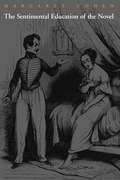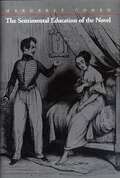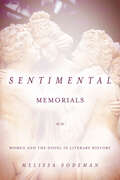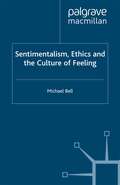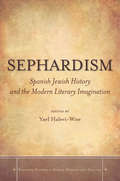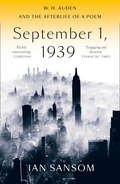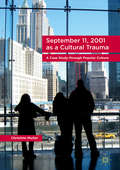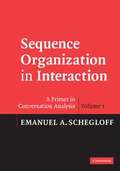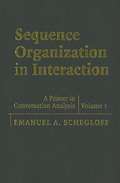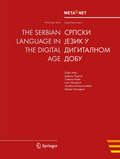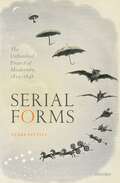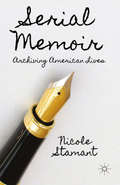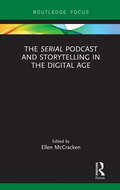- Table View
- List View
Sentimental Bodies: Sex, Gender, and Citizenship in the Early Republic
by Bruce BurgettSentimentalism, sex, the construction of the modern body, and the origins of American liberalism all come under scrutiny in this rich discussion of political life in the early republic. Here Bruce Burgett enters into debates over the "public sphere," a concept introduced by Jurgen Habermas that has led theorists to grapple with such polarities as public and private, polity and personality, citizenship and subjection. With the literary public sphere as his primary focus, Burgett sets out to challenge the Enlightenment opposition of reason and sentiment as the fundamental grid for understanding American political culture. Drawing on texts ranging from George Washington's "Farewell Address" and Charles Brockden Brown's Clara Howard to Hannah Foster's The Coquette and Harriet Jacobs's Incidents in the Life of a Slave Girl, Burgett shows that the sentimental literary culture of the period relied on readers' affective, passionate, and embodied responses to fictive characters and situations in order to produce political effects. As such, sentimentalism located readers' bodies both as prepolitical sources of personal authenticity and as public sites of political contestation. Going beyond an account of the public sphere as a realm to which only some have full access, Burgett reveals that the formation of the body and sexual subjectivity is crucial to the very construction of that sphere. By exploring and destabilizing the longstanding distinction between public and private life, this book raises questions central to any democratic political culture.
The Sentimental Education of the Novel
by Margaret CohenThe nineteenth-century French novel has long been seen as the heroic production of great men, who confronted in their works the social consequences of the French Revolution. And it is true that French realism, especially as developed by Balzac and Stendhal, was one of the most influential novelistic forms ever invented. Margaret Cohen, however, challenges the traditional account of the genesis of realism by returning Balzac and Stendhal to the forgotten novelistic contexts of their time. Reconstructing a key formative period for the novel, she shows how realist codes emerged in a "hostile take-over" of a prestigious contemporary sentimental practice of the novel, which was almost completely dominated by women writers. Cohen draws on impressive archival research, resurrecting scores of forgotten nineteenth-century novels, to demonstrate that the codes most closely identified with realism were actually the invention of sentimentality, a powerful aesthetic of emerging liberal-democratic society, although Balzac and Stendhal trivialized sentimental works by associating them with "frivolous" women writers and readers. Attention to these gendered struggles over genre explains why women were not pioneers of realism in France during the nineteenth century, a situation that contrasts with England, where women writers played a formative role in inventing the modern realist novel. Cohen argues that to understand how literary codes respond to material factors, it is imperative to see how such factors take shape within the literary field as well as within society as a whole. The book also proposes that attention to literature as a social institution will help critics resolve the current, vital question of how to practice literary history in the wake of poststructuralism.
The Sentimental Education of the Novel (PDF)
by Margaret CohenThe nineteenth-century French novel has long been seen as the heroic production of great men, who confronted in their works the social consequences of the French Revolution. And it is true that French realism, especially as developed by Balzac and Stendhal, was one of the most influential novelistic forms ever invented. Margaret Cohen, however, challenges the traditional account of the genesis of realism by returning Balzac and Stendhal to the forgotten novelistic contexts of their time. Reconstructing a key formative period for the novel, she shows how realist codes emerged in a "hostile take-over" of a prestigious contemporary sentimental practice of the novel, which was almost completely dominated by women writers. Cohen draws on impressive archival research, resurrecting scores of forgotten nineteenth-century novels, to demonstrate that the codes most closely identified with realism were actually the invention of sentimentality, a powerful aesthetic of emerging liberal-democratic society, although Balzac and Stendhal trivialized sentimental works by associating them with "frivolous" women writers and readers. Attention to these gendered struggles over genre explains why women were not pioneers of realism in France during the nineteenth century, a situation that contrasts with England, where women writers played a formative role in inventing the modern realist novel. Cohen argues that to understand how literary codes respond to material factors, it is imperative to see how such factors take shape within the literary field as well as within society as a whole. The book also proposes that attention to literature as a social institution will help critics resolve the current, vital question of how to practice literary history in the wake of poststructuralism.
Sentimental Figures of Empire in Eighteenth-Century Britain and France
by Lynn FestaIn this ambitious and original study, Lynn Festa examines how and why sentimental fiction became one of the primary ways of representing British and French relations with colonial populations in the eighteenth century. Drawing from novels, poetry, travel narratives, commerce manuals, and philosophical writings, Festa shows how sentimentality shaped communal and personal assertions of identity in an age of empire.Read in isolation, sentimental texts can be made to tell a simple story about the emergence of the modern psychological self. Placed in conversation with empire, however, sentimentality invites both psychological and cultural readings of the encounter between self and other. Sentimental texts, Festa claims, enabled readers to create powerful imagined relations to distant people. Yet these emotional bonds simultaneously threatened the boundaries between self and other, civilized and savage, colonizer and colonized. Festa argues that sentimental tropes and figures allowed readers to feel for others, while maintaining the particularity of the individual self. Sentimental identification thus operated as a form of differentiation as well as consolidation.Festa contends that global reach increasingly outstripped imaginative grasp during this era. Sentimentality became an important tool for writers on empire, allowing conquest to be portrayed as commerce and scenes of violence and exploitation to be converted into displays of benevolence and pity. Above all, sentimental texts used emotion as an important form of social and cultural distinction, as the attribution of sentience and feeling helped to define who would be recognized as human.
Sentimental Memorials: Women and the Novel in Literary History
by Melissa SodemanDuring the later eighteenth century, changes in the meaning and status of literature left popular sentimental novels stranded on the margins of literary history. While critics no longer dismiss or ignore these works, recent reassessments have emphasized their interventions in various political and cultural debates rather than their literary significance. Sentimental Memorials, by contrast, argues that sentimental novels gave the women who wrote them a means of clarifying, protesting, and finally memorializing the historical conditions under which they wrote. As women writers successfully navigated the professional marketplace but struggled to position their works among more lasting literary monuments, their novels reflect on what the elevation of literature would mean for women's literary reputations. Drawing together the history of the novel, women's literary history, and book history, Melissa Sodeman revisits the critical frameworks through which we have understood the history of literature. Novels by Sophia Lee, Ann Radcliffe, Charlotte Smith, and Mary Robinson, she argues, offer ways of rethinking some of the signal literary developments of this period, from emerging notions of genius and originality to the rise of an English canon. And in Sodeman's analysis, novels long seen as insufficiently literary acquire formal and self-historicizing importance.
Sentimentalism, Ethics and the Culture of Feeling
by M. BellSentimentalism, Ethics and the Culture of Feeling defends feeling against customary distrust or condescension by showing that the affective turn of the eighteenth-century cult of sentiment, despite its sometimes surreal manifestations, has led to a positive culture of feeling. The very reaction against sentimentalism has taught us to identity sentimentality. Fiction, moreover, remains a principal means not just of discriminating quality of feeling but of appreciating its essentially imaginative nature.
Sephardism: Spanish Jewish History and the Modern Literary Imagination (Stanford Studies in Jewish History and Culture #180)
by Yael Halevi-WiseIn this book, Sephardism is defined not as an expression of Sephardic identity but as a politicized literary metaphor. Since the nineteenth century, this metaphor has occurred with extraordinary frequency in works by authors from a variety of ethnicities, religions, and nationalities in Europe, the Americas, North Africa, Israel, and even India. Sephardism asks why Gentile and Jewish writers and cultural figures have chosen to draw upon the medieval Sephardic experience to express their concerns about dissidents and minorities in modern nations? To what extent does their use of Sephardism overlap with other politicized discourses such as orientalism, hispanism, and medievalism, which also emerged from a clash between authoritarian, progressive, and romantic ideologies? This book brings a new approach to Sephardic Studies by situating it at a crossroads between Jewish Studies and Hispanic Studies in ways that enhance our appreciation of how historical fiction and political history have shaped, and were shaped by, historical attitudes toward Jews and their representation.
September 1, 1939: A Biography Of A Poem
by Ian SansomThis is a book about a poet, about a poem, about a city, and about a world at a point of change. More than a work of literary criticism or literary biography, it is a record of why and how we create and respond to great poetry.
September 11, 2001 as a Cultural Trauma: A Case Study through Popular Culture
by Christine MullerThis book investigates the September 11, 2001 attacks as a case study of cultural trauma, as well as how the use of widely-distributed, easily-accessible forms of popular culture can similarly focalize evaluation of other moments of acute and profoundly troubling historical change. The attacks confounded the traditionally dominant narrative of the American Dream, which has persistently and pervasively featured optimism and belief in a just world that affirms and rewards self-determination. This shattering of a worldview fundamental to mainstream experience and cultural understanding in the United States has manifested as a cultural trauma throughout popular culture in the first decade of the twenty-first century. Popular press oral histories, literary fiction, television, and film are among the multiple, ubiquitous sites evidencing preoccupations with existential crisis, vulnerability, and moral ambivalence, with fate, no-win scenarios, and anti-heroes now pervading commonly-told and readily-accessible stories. Christine Muller examines how popular culture affords sites for culturally-traumatic events to manifest and how readers, viewers, and other audiences negotiate their fallout.
September 11, 2001 as a Cultural Trauma: A Case Study through Popular Culture
by Christine MullerThis book investigates the September 11, 2001 attacks as a case study of cultural trauma, as well as how the use of widely-distributed, easily-accessible forms of popular culture can similarly focalize evaluation of other moments of acute and profoundly troubling historical change. The attacks confounded the traditionally dominant narrative of the American Dream, which has persistently and pervasively featured optimism and belief in a just world that affirms and rewards self-determination. This shattering of a worldview fundamental to mainstream experience and cultural understanding in the United States has manifested as a cultural trauma throughout popular culture in the first decade of the twenty-first century. Popular press oral histories, literary fiction, television, and film are among the multiple, ubiquitous sites evidencing preoccupations with existential crisis, vulnerability, and moral ambivalence, with fate, no-win scenarios, and anti-heroes now pervading commonly-told and readily-accessible stories. Christine Muller examines how popular culture affords sites for culturally-traumatic events to manifest and how readers, viewers, and other audiences negotiate their fallout.
Sequel to History: Postmodernism and the Crisis of Representational Time
by Elizabeth Deeds ErmarthSequel to History offers a comprehensive definition of postmodernism as a reformation of time. Elizabeth Deeds Ermarth uses a diversified theoretical approachdrawing on post-structuralism, feminism, new historicism, and twentieth-century scienceto demonstrate the crisis of our dominant idea of history and its dissolution in the rhythmic time of postmodernism. She enlarges this definition in discussions of several crises of cultural identity: the crisis of the object, the crisis of the subject, and the crisis of the sign. Finally, she explores the relation between language and time in post-modernism, proposing an arresting theory of her own about the rhythmic nature of postmodern temporality. Because the postmodern construction of time appears so clearly in narrative writing, each part of this work is punctuated by a "rhythm section" on a postmodern narrative (Robbe-Grillet's Jealousy, Cortezar's Hopscotch, and Nabokov's Ada); these extended readings provide concrete illustrations of Ermarth's theoretical positions. As in her critically acclaimed Realism and Consensus in the English Novel, Ermarth ranges across disciplines from anthropology and the visual arts to philosophy and history. For its interdisciplinary character and its lucid definition of postmodernism, Sequel to History will appeal to all those interested in the humanities.
Sequel to History: Postmodernism and the Crisis of Representational Time
by Elizabeth Deeds ErmarthSequel to History offers a comprehensive definition of postmodernism as a reformation of time. Elizabeth Deeds Ermarth uses a diversified theoretical approachdrawing on post-structuralism, feminism, new historicism, and twentieth-century scienceto demonstrate the crisis of our dominant idea of history and its dissolution in the rhythmic time of postmodernism. She enlarges this definition in discussions of several crises of cultural identity: the crisis of the object, the crisis of the subject, and the crisis of the sign. Finally, she explores the relation between language and time in post-modernism, proposing an arresting theory of her own about the rhythmic nature of postmodern temporality. Because the postmodern construction of time appears so clearly in narrative writing, each part of this work is punctuated by a "rhythm section" on a postmodern narrative (Robbe-Grillet's Jealousy, Cortezar's Hopscotch, and Nabokov's Ada); these extended readings provide concrete illustrations of Ermarth's theoretical positions. As in her critically acclaimed Realism and Consensus in the English Novel, Ermarth ranges across disciplines from anthropology and the visual arts to philosophy and history. For its interdisciplinary character and its lucid definition of postmodernism, Sequel to History will appeal to all those interested in the humanities.
Sequence Organization In Interaction: A Primer In Conversation Analysis (PDF)
by Emanuel A. SchegloffMuch of our daily lives are spent talking to one another, in both ordinary conversation and more specialized settings such as meetings, interviews, classrooms, and courtrooms. It is largely through conversation that the major institutions of our society - economy, religion, politics, family and law - are implemented. This book Emanuel Schegloff, the first in a series and first published in 2007, introduces the findings and theories of conversation analysis. Together, the volumes in the series constitute a complete and authoritative 'primer' in the subject. The topic of this first volume is 'sequence organization' - the ways in which turns-at-talk are ordered and combined to make actions take place in conversation, such as requests, offers, complaints, and announcements. Containing many examples from real-life conversations, it will be invaluable to anyone interested in human interaction and the workings of conversation.
Sequence Organization In Interaction (PDF): A Primer In Conversation Analysis
by Emanuel A. SchegloffMuch of our daily lives are spent talking to one another, in both ordinary conversation and more specialized settings such as meetings, interviews, classrooms, and courtrooms. It is largely through conversation that the major institutions of our society - economy, religion, politics, family and law - are implemented. This book Emanuel Schegloff, the first in a series and first published in 2007, introduces the findings and theories of conversation analysis. Together, the volumes in the series constitute a complete and authoritative 'primer' in the subject. The topic of this first volume is 'sequence organization' - the ways in which turns-at-talk are ordered and combined to make actions take place in conversation, such as requests, offers, complaints, and announcements. Containing many examples from real-life conversations, it will be invaluable to anyone interested in human interaction and the workings of conversation.
The Serbian Language in the Digital Age (White Paper Series)
by Georg Rehm Hans UszkoreitThis white paper is part of a series that promotes knowledge about language technology and its potential. It addresses educators, journalists, politicians, language communities and others. The availability and use of language technology in Europe varies between languages. Consequently, the actions that are required to further support research and development of language technologies also differ for each language. The required actions depend on many factors, such as the complexity of a given language and the size of its community. META-NET, a Network of Excellence funded by the European Commission, has conducted an analysis of current language resources and technologies. This analysis focused on the 23 official European languages as well as other important national and regional languages in Europe. The results of this analysis suggest that there are many significant research gaps for each language. A more detailed expert analysis and assessment of the current situation will help maximise the impact of additional research and minimize any risks. META-NET consists of 54 research centres from 33 countries that are working with stakeholders from commercial businesses, government agencies, industry, research organisations, software companies, technology providers and European universities. Together, they are creating a common technology vision while developing a strategic research agenda that shows how language technology applications can address any research gaps by 2020.
Seren Iaith!: llawlyfr adolygu cywiro iaith (PDF)
by Nona Breese Bethan ClementTargedir y prif wallau a welir yn iaith y dysgwyr o ddydd i ddydd. Ceir yma gyfres o ymarferion byr a difyr wedi’u trefnu’n ddwy adran hylaw. Gellir defnyddio’r ymarferion o dan arweiniad athrawon neu gall dysgwyr eu defnyddio’n annibynnol gan fod atebion posibl hefyd wedi’u cynnwys. Mae’r adran gyntaf yn ymdrin â gwahanol agweddau ar ramadeg yr iaith, e.e. arddodiaid, treigladau ac ati. Ceir esboniad gramadegol cryno a chlir ar elfen unigol ac yna tasg i’r dysgwyr gael ymarfer y rheol dan sylw. Mae deg eitem ym mhob ymarfer oni nodir yn wahanol. Mae’r ail adran yn cynnwys ymarferion sy’n cyfuno’r elfennau ieithyddol a gafodd sylw yn rhan gyntaf y llyfr. Felly, mae pob ymarfer yn rhoi sylw i amrywiaeth o wallau cyffredin. Mae’r ymarferion yn y ddwy adran yn cynnwys brawddegau unigol ac ystod o ffurfiau fel e-byst, hysbysebion, llythyron, paragraffau o waith dysgwyr, cyfarwyddiadau ac ati. Mae’r cyd-destunau’n ddifyr ac yn gyfoes ac yn sicr o apelio at bobl ifanc. Mae amrywiaeth o ymarferion gwahaniaethol yma, e.e. cywiro neu brawf ddarllen, llenwi bylchau, gosod terfyniad cywir, nodi treiglad, dethol ffurf gywir berf neu arddodiad o ddewis a roddir ac ati.
Serendipity in Rhetoric, Writing, and Literacy Research
by Maureen Daly Goggin and Peter N. GogginIn the course of research, most scholars have known moments of surprise, catastrophe, or good fortune, though they seldom refer to these occurrences in reports or discuss them with students. Serendipity in Rhetoric, Writing, and Literacy Research reveals the different kinds of work scholars, particularly those in rhetoric, writing, and literacy, need to do in order to recognize a serendipitous discovery or a missed opportunity. In published scholarship and research, the path toward discovery seems clean and direct. The dead ends, backtrackings, start-overs, and stumbles that occur throughout the research process are elided, and seems that the researchers started at point A and arrived safely and neatly at point B without incident, as if by magic. The path, however, is never truly clear and straight. Research and writing is messy. Serendipity in Rhetoric, Writing, and Literacy Research features chapters from twenty-three writing scholars who have experienced moments of serendipity in their own work—not by magic or pure chance but through openness and active waiting, which offer an opportunity to prepare the mind. Serendipity in Rhetoric, Writing, and Literacy Research illustrates the reality of doing research: there is no reliable prescription or one-size-fits-all manual, but success can be found with focused dedication and an open mind. Contributors: Ellen Barton, Zachary C. Beare, Lynn Z. Bloom, Jennifer Clary-Lemon, Caren Wakerman Converse, Gale Coskan-Johnson, Kim Donehower, Bill Endres, Shirley E. Faulkner-Springfield, Lynée Lewis Gaillet, Brad Gyori, Judy Holiday, Gesa E. Kirsch, Lori Ostergaard, Doreen Piano, Liz Rohan, Ryan Skinnell, Patricia Wilde, Daniel Wuebben
Sergio Raimondi, Selected Poems (Aris & Phillips Hispanic Classics)
by Ben Bollig Mark LeechSergio Raimondi’s work engages in the most complex issues of his time, including globalisation, colonialism, industrialisation and environmental degradation. Yet all his concerns are rigorously analysed through the medium of the poet’s art, steeped in literary tradition and craft. He is widely considered Argentina’s most important and influential contemporary poet, with an international reputation. Many of Raimondi’s poems address what might seem unlikely subjects for poetry: industrial practices, global trade, or labour legislation. Yet among the allusions, the immense research, the unsparing gaze, and the expert skill of the language there’s also room for desert-dry humour, touches of self-deprecation and immense empathy for individuals caught up in seemingly implacable historical processes. This volume includes a generous selection of his poems from Poesía civil (Civil Poetry) and Lexikón (Lexikon) in bilingual Spanish-English facing-pages format. A substantial introduction by the translators places Raimondi’s work in its literary and wider cultural context, and reflects on the challenges faced when bringing his unique poetry into English.
Serial Crime Fiction: Dying for More (Crime Files)
by Jean AndersonSerial Crime Fiction is the first book to focus explicitly on the complexities of crime fiction seriality. Covering definitions and development of the serial form, implications of the setting, and marketing of the series, it studies authors such as Doyle, Sayers, Paretsky, Ellroy, Marklund, Camilleri, Borges, across print, film and television.
Serial Encounters: Ulysses and the Little Review
by Clare HuttonJames Joyce's Ulysses was first published in New York in the Little Review between 1918 and 1920. What kind of reception did it have and how does the serial version of the text differ from the version most readers know, the iconic volume edition published in Paris in 1922 by Shakespeare and Company? Joyce prepared much of Ulysses for serial publication while resident in Zurich between 1915 and 1919. This original study, based on sustained archival research, goes behind the scenes in Zurich and New York in order to recover long forgotten facts that are pertinent to the writing, reception, and interpretation of Ulysses. The Little Review serialization of Ulysses proved controversial from the outset and was ultimately stopped before Joyce had completed the work. The New York Society for the Suppression of Vice had taken successful legal action against the journal's editors, on the grounds that the final instalment of the thirteenth chapter of Ulysses was obscene. This triumph of the social purity movement had far reaching repercussions for Joyce's subsequent publishing history, and for his ongoing efforts with the composition of Ulysses. After chapters of contextual literary history (on the cultural world of the Little Review; the early production history of Ulysses; and the New York trial of 1921), the study moves to a consideration of the textual significance of the serialization. It breaks new ground in Joycean scholarship by paying critical attention to Ulysses as a serial text. The study concludes by examining the myriad ways in which Joyce revised and augmented Ulysses while resident in Paris; it shows how Joyce made Ulysses more sexually suggestive and overt, in explicit response to the work's legal reception in New York.
Serial Encounters: Ulysses and the Little Review
by Clare HuttonJames Joyce's Ulysses was first published in New York in the Little Review between 1918 and 1920. What kind of reception did it have and how does the serial version of the text differ from the version most readers know, the iconic volume edition published in Paris in 1922 by Shakespeare and Company? Joyce prepared much of Ulysses for serial publication while resident in Zurich between 1915 and 1919. This original study, based on sustained archival research, goes behind the scenes in Zurich and New York in order to recover long forgotten facts that are pertinent to the writing, reception, and interpretation of Ulysses. The Little Review serialization of Ulysses proved controversial from the outset and was ultimately stopped before Joyce had completed the work. The New York Society for the Suppression of Vice had taken successful legal action against the journal's editors, on the grounds that the final instalment of the thirteenth chapter of Ulysses was obscene. This triumph of the social purity movement had far reaching repercussions for Joyce's subsequent publishing history, and for his ongoing efforts with the composition of Ulysses. After chapters of contextual literary history (on the cultural world of the Little Review; the early production history of Ulysses; and the New York trial of 1921), the study moves to a consideration of the textual significance of the serialization. It breaks new ground in Joycean scholarship by paying critical attention to Ulysses as a serial text. The study concludes by examining the myriad ways in which Joyce revised and augmented Ulysses while resident in Paris; it shows how Joyce made Ulysses more sexually suggestive and overt, in explicit response to the work's legal reception in New York.
Serial Forms: The Unfinished Project of Modernity, 1815-1848
by Clare PettittSerial Forms: The Unfinished Project of Modernity, 1815-1848 proposes an entirely new way of reading the transition into the modern. It is the first book in a series of three which will take the reader up to the end of the First World War, moving from a focus on London to a global perspective. Serial Forms sets out the theoretical and historical basis for all three volumes. It suggests that, as a serial news culture and a stadial historicism developed together between 1815 and 1848, seriality became the dominant form of the nineteenth century. Through serial newsprint, illustrations, performances, and shows, the past and the contemporary moment enter into public visibility together. Serial Forms argues that it is through seriality that the social is represented as increasingly politically urgent. The insistent rhythm of the serial reorganizes time, recalibrates and rescales the social, and will prepare the way for the 1848 revolutions which are the subject of the next book. By placing their work back into the messy print and performance culture from which it originally appeared, Serial Forms is able to produce new and exciting readings of familiar authors such as Scott, Byron, Dickens, and Gaskell. Rather than offering a rarefied intellectual history or chopping up the period into 'Romantic' and 'Victorian', Clare Pettitt tracks the development of communications technologies and their impact on the ways in which time, history and virtuality are imagined.
Serial Forms: The Unfinished Project of Modernity, 1815-1848
by Clare PettittSerial Forms: The Unfinished Project of Modernity, 1815-1848 proposes an entirely new way of reading the transition into the modern. It is the first book in a series of three which will take the reader up to the end of the First World War, moving from a focus on London to a global perspective. Serial Forms sets out the theoretical and historical basis for all three volumes. It suggests that, as a serial news culture and a stadial historicism developed together between 1815 and 1848, seriality became the dominant form of the nineteenth century. Through serial newsprint, illustrations, performances, and shows, the past and the contemporary moment enter into public visibility together. Serial Forms argues that it is through seriality that the social is represented as increasingly politically urgent. The insistent rhythm of the serial reorganizes time, recalibrates and rescales the social, and will prepare the way for the 1848 revolutions which are the subject of the next book. By placing their work back into the messy print and performance culture from which it originally appeared, Serial Forms is able to produce new and exciting readings of familiar authors such as Scott, Byron, Dickens, and Gaskell. Rather than offering a rarefied intellectual history or chopping up the period into 'Romantic' and 'Victorian', Clare Pettitt tracks the development of communications technologies and their impact on the ways in which time, history and virtuality are imagined.
Serial Memoir: Archiving American Lives
by N. StamantSerial Memoir chronicles the phenomenon of seriality in memoir, a transition in life writing toward repeated acts of self-representation in the later twentieth century. Such a shift demonstrates a new way to understand and represent constantly-shifting subjectivities and their ambivalent relationship to the concept and structure of the archive.
The Serial Podcast and Storytelling in the Digital Age (Routledge Focus on Digital Media and Culture)
by Ellen McCrackenThis volume analyzes the Serial podcast, situating it in the trajectory of other popular crime narratives and contemporary cultural theory. Contributors focus on topics such as the ethics of the use of fiction techniques in investigative journalism, the epistemological overlay of postmodern indeterminacy, and the audience’s prolific activity in social media, examining the competing narrative strategies of the narrators, characters, and the audience. Other topics considered include the multiplication of narratives and the longing for closure, how our minds work as we experience true crime narratives, and what critical race theory can teach us about the program’s strategies.

